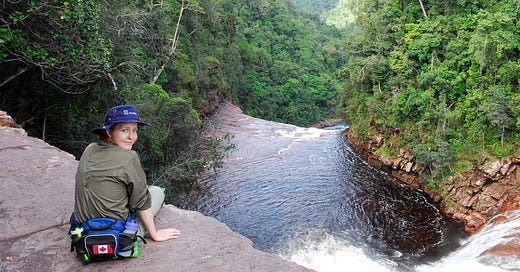Risking Life and Limb to Catalog the World’s Plants
“Plant collection” may not sound perilous, but while scaling boulders and dodging snakes, I learned just how much these intrepid explorers risk to help understand our world.
Writing this Narratively Classic represented the first time I’d ever written about my work as a botanist. At the time, I had only recently left research and was trying to find myself as a science writer. All I knew was that I had a great deal to say about both plants and my experiences in research. I put forth my most exciting, adventurous story about the risky but worthwhile work of being a botanical collector, hoping to one day expand it into a book that would inform readers about the wonders of plants and how important the study of botany is in this age of habitat loss and extinction. This year, my dream is being realized and this story has become a chapter in my first book, Unrooted: Botany, Motherhood, and the Fight to Save an Old Science, which comes out on Tuesday, April 16. I hope this piece will one day represent the first step of many for me in working to inspire others to learn about and protect the more than 400,000 plant species on Earth.
—Erin Zimmerman
It’s our third week in the Guyanese rainforest, and we’ve hiked out to the base of a small but fast-moving waterfall to see what plants we can collect around the wet rock face. Getting to it involves scrambling over a series of large boulders with long drops to one side. It would be a nerve-wracking climb at the best of times, but as we get about a third of the way up, it starts to pour in that abrupt fashion particular to the tropics. The mossy rocks instantly become slippery to the touch, and it isn’t clear whether it’s less dangerous to keep going or try descending back the way we’ve come.
We decide to keep going, and manage to get to the rock face to make some collections, including a few delicate orchids clinging to the stone. But it’s obvious we aren’t going to get back down the way we’ve come. One of the field assistants who has stayed below circles around and cuts a path through the dense forest near the top of the falls. It’s an alternate way out, but we still have to get up to the head of the trail he’s cut. That means climbing a near-vertical wall of wet cut-grass, a plant named for its hand-slicing capacity. I press myself into it, grab the cut-grass and try to scramble up. Anytime I stop scrambling for a moment, I start to backslide, slipping down the grassy wall toward the huge boulders and rushing water below.
After a few minutes of frenzied activity, I peek my head over the top of the wall. As someone with a profound snake phobia, I’m considering that the ill-timed appearance of one right now would be the end of me. The universe must have laughed at that thought, because just then, what looks like a terrier-sized rat pokes its face out of the bushes inches in front of me. I’m so startled that I nearly lose my grip and plummet to a grisly fate below.
Some deeply buried instinct for survival thankfully surfaces just in time and I grab the grass before the point of no return. It takes the entirety of my willpower to remain motionless in front of what turns out to be a creature the Guyanese call a labba: Cuniculus paca, a harmless South American rodent that can reach up to 25 pounds. Making our way back to our field site, feeling the exhaustion that follows in the wake of a flood of adrenaline, it occurs to me that I’ve just risked life and limb for the sake of some dried plants.
Keep reading with a 7-day free trial
Subscribe to Narratively to keep reading this post and get 7 days of free access to the full post archives.





